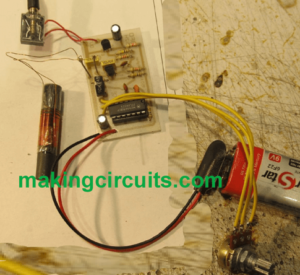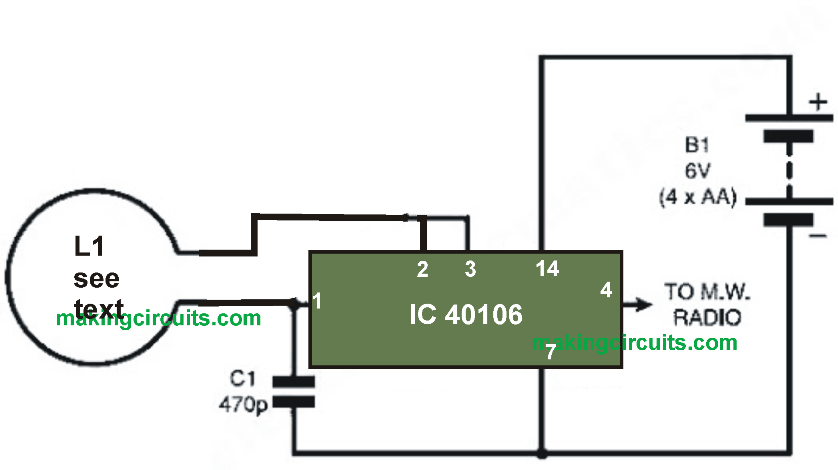In this post we learn how to make a simplest metal detector circuit using a single CMOS IC 40106

Simple metal detector circuit
The metal detection circuit displayed here might reveal the limitations of the simpleness of a metal detector, however the design performs remarkably well. It works with a single 40106 hexadecimal incinerator, a capacitor and a search coil not to mention the batteries. One pin of IC1b pin 4 has to be linked to a medium wave radio antenna, or it ought to be twisted round the radio. It could be employed even as a portable metal detectors.
As mentioned, the metal detector comes with a reputable range for beat frequency operation (bfo) as much as 90 mm. In reality, for ease-of-use, the capacitor C1 may be removed. In this manner, the I noticed an amazing range of 150 mm. On the other hand, as the frequency is increased to over 4MHz, lack of stability turns into a significant issue.

Metal detector diagram
As displayed, the circuit oscillates close to 230 kHz. The frequency can even be examined by altering the value of C1. A Faraday shield could be included in minimize ground effect and capacitive coupling, which is wired to 0V.
Considering that the inductor L1 is tolerant to the rapid changeover voltage, the load of C1 seems to be a bit retarded once the logic level of IC1a pin 2 varies. This produces a rapid fluctuation, that is caught by an MW radio. Any kind of modification in the inductance of the search coil through the (presence|occurrence} of metal) leads to an alteration in the frequency of the oscillator. Even though 230kHz no longer has enough range of the Medium Wave band, a MW radio may evidently recapture the harmonics of this frequency.
How to Calibrate the Metal Detector
The making of the L1 search coil lets plenty of margin for error and is also faraway from criticality. I, in my prototype applied 70 turns 30 inches (.315 mm) of enamelled copper wire with 120 mm in diameter.
The metal detector is set up by adjusting the MW radio to whistle. Not every of the harmonics work effectively, and the best suited one need to be identified. The existence of metal will evidently affect the tone of the whistle.
Please Note:
The explained circuit isn't a commercial or security metal detector and is definitely not a metal detection product. It's simply a portable metal detector and, not a full-fledged hand-held metal detector.
Search for a short, effective and proven scheme for a metal detector